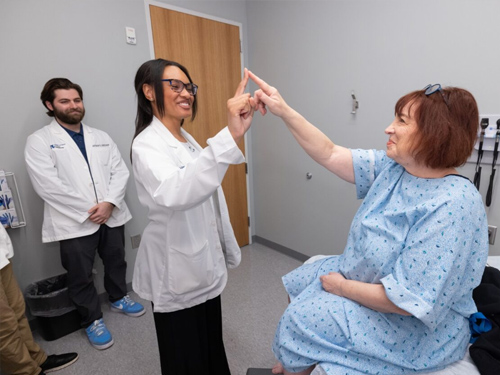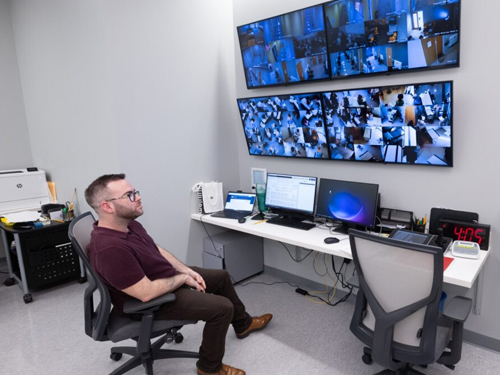Clinical Education & Assessment Center
Teaching Clinical Skills

Applying knowledge learned in the classroom to the actual care of patients can be a major transition for students in medicine and other health care professions. At Drexel University College of Medicine, state-of-the-art Clinical Education Assessment Centers (CEACs) provide custom-designed settings where students can learn, practice and be evaluated on the skills they will need to communicate and work effectively with patients. The CEACs are also ideal for continuing education for physicians and other practicing health professionals.
The CEACs have fully equipped exam rooms, flexible rooms that can be utilized for meetings, training, orientations, debriefs or as additional exam rooms, and state-of-the-art control rooms. In the exam rooms, which replicate a physician's examining room or a hospital room, trainees work with specially trained standardized patients. Faculty observe their interactions through a video audio simulation program and can communicate with the trainee or patient by paging through overhead microphones.

Each room is equipped with a color video camera. Video can be transmitted to a separate observation room, where a faculty member can view multiple patient-trainee encounters on a bank of monitors. (Professional development programs at the College use this arrangement to teach clinical skills evaluation to faculty members.) The technology also enables faculty at any of our campuses to serve as evaluators through our videoconferencing system.
The medical students' clinical skills videos are maintained in a database over their four years of medical school, enabling them to observe their performance and improvement over time. Faculty members review these videotapes with students to provide feedback on their clinical development.
Computerization and installation of advanced audiovisual equipment has made the CEACs the most sophisticated facilities of their kind in the world. The patient and trainee activity checklists are computerized, thus providing timely, valuable feedback with printed score reports, often within an hour.
Using Standardized Patients
Standardized patients are part-time employees who are specially trained to act as patients. They serve as a resource for teaching and evaluating clinical skills, including physical examination, communications, history-taking, patient counseling and patient education. Each standardized patient is given a specific medical complaint or role and is taught how to give a medical history and to undergo a physical examination. Some of the symptoms and physical findings of these "patients" are real, while others are simulated.
A professional trainer and faculty members prepare standardized patients for their roles. Standardized patients can assist in both teaching and evaluation of students. They are also trained to provide constructive feedback regarding the completeness and style of the "doctor-patient" encounter.
Using standardized patients also provides an opportunity to create simulations of duties that are difficult to handle, such as notifying the family when a patient dies or coping with an angry patient. This practice helps prepare trainees for real-life events, without adverse consequences for themselves or the patient.
Learn more about the Standardized Patient program
CEAC Programs
A variety of programs at all educational levels use the Clinical Education Assessment Centers at our campuses in University City, Philadelphia and West Reading, Pa.
- Medical students begin training in the CEAC in their first year, learning the basics of patient interviewing and physical examination skills. Comprehensive clinical skills training continues throughout the four years, including a fourth-year Clinical Practice Examination to assess clinical skills competency prior to graduation.
- Residency programs use the CEAC to determine the skill levels of incoming residents and to hone skills in specific areas.
- A 10-station OSCE (objective structured clinical exercise) is administered as continuing education for practicing physicians. Determining the learning needs of specialist physicians who plan to retrain as generalists is another use of the CEAC.
- Similar types of programs have been developed for nursing and other allied health professions students.
- The CEAC has many other academic purposes. For example, a series of videotaped case vignettes is used to stimulate discussion in faculty development programs. Another program utilized CEAC to educate health care providers about the special needs of patients with spinal injury. The design of the CEAC in combination with the Standardized Patient Program provides an extremely useful and adaptable teaching and assessment tool.
- Other medical schools in the region and other programs use our CEACs for training and assessment in collaboration with members of the Clinical Skills Education and Assessment Division. Members of the division also act as consultants to other schools nationwide, advising them on the development of similar programs or facilities.
Contact the Clinical Education Assessment Center
For more information, please contact the director of clinical skills education and assessment at:
Office of Educational Affairs
Drexel University College of Medicine
36 N. 36th Street
Philadelphia, PA 19104
Phone: 215.991.8528
Contact Information
Drexel University College of Medicine
Office of Admissions
60 N. 36th Street, Philadelphia, PA 19104
215.991.8202
Back to Top